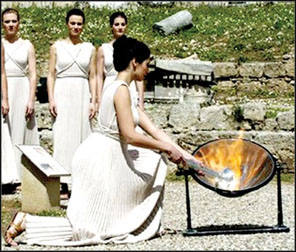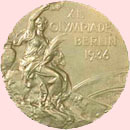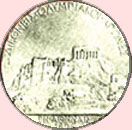Olympics then and now
The Olympic Flame
 The Olympic flame is a practice continued from the ancient Olympic
Games. In Olympia (Greece), a flame was ignited by the Sun and then kept
burning until the closing of the Olympic Games. The flame first appeared
in the modern Olympics at the 1928 Olympic Games in Amsterdam. The Olympic flame is a practice continued from the ancient Olympic
Games. In Olympia (Greece), a flame was ignited by the Sun and then kept
burning until the closing of the Olympic Games. The flame first appeared
in the modern Olympics at the 1928 Olympic Games in Amsterdam.
The flame itself represents a number of things, including purity and
the endeavor for perfection. In 1936, the chairman of the organising
committee for the 1936 Olympic Games, Carl Diem, suggested what is now
the modern Olympic Torch relay. The Olympic flame is lit at the ancient
site of Olympia by women wearing ancient-style robes and using a curved
mirror and the sun.
The Olympic Torch is then passed from runner to runner, from the
ancient site of Olympia to the Olympic stadium in the hosting city. The
flame is then kept alight until the Games have concluded. The Olympic
Torch relay represents a continuation from the ancient Olympic Games to
the modern Olympics.
The Official Olympic Flag
 Created by Pierre de Coubertin in 1914, the Olympic flag contains
five interconnected rings on a white background. The five rings
symbolise the five significant continents and are interconnected to
symbolise the friendship to be gained from these international
competitions. Created by Pierre de Coubertin in 1914, the Olympic flag contains
five interconnected rings on a white background. The five rings
symbolise the five significant continents and are interconnected to
symbolise the friendship to be gained from these international
competitions.
The rings, from left to right, are blue, yellow, black, green, and
red. The colours were chosen because at least one of them appeared on
the flag of every country in the world. The Olympic flag was first flown
during the 1920 Olympic Games.
The Olympic Motto
In 1921, Pierre de Coubertin, founder of the modern Olympic Games,
borrowed a Latin phrase from his friend, Father Henri Didon, for the
Olympic motto: Citius, Altius, Fortius (“Swifter, Higher, Stronger”).
The Olympic Oath
Pierre de Coubertin wrote an oath for the athletes to recite at each
Olympic Games.During the opening ceremonies, one athlete recites the
oath on behalf of all the athletes. The Olympic oath was first taken
during the 1920 Olympic Games by Belgian fencer Victor Boin.
The Olympic Hymn
The Olympic Hymn, played when the Olympic Flag is raised, was
composed by Spyros Samaras and the words added by Kostis Palamas. The
Olympic Hymn was first played at the 1896 Olympic Games in Athens but
wasn’t declared the official hymn by the IOC until 1957.
The First Opening Ceremonies
The first opening ceremonies were held during the 1908 Olympic Games
in London.
Real Gold Medals
 |
 |
 |
|
The 1936 gold
medal |
1896
medal(obverse and reverse) |
|
The last Olympic gold medals that were made entirely out of gold were
awarded in 1912.
The Medals
The Olympic medals are designed especially for each individual
Olympic Games by the host city’s organising committee. Each medal must
be at least three millimetres thick and 60 millimetres in diameter.
Also, the gold and silver Olympic medals must be made out of 92.5 per
cent silver, with the gold medal covered in six grams of gold.
Olympic medals have no standard design.
|
